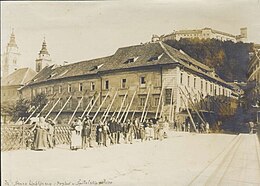1895 Ljubljana earthquake
Appearance
 Hospice Street (Špitalska ulica; now Stritar Street, Stritarjeva ulica) | |
| UTC time | 1895-04-14 22:17 |
|---|---|
| Local date | 14 April 1895 |
| Local time | 23:17 |
| Magnitude | 6.1 (Mw )[1] |
| Depth | 16 km (9.9 mi)[1] |
| Epicenter | 46°3′8.83″N 14°42′39.27″E / 46.0524528°N 14.7109083°E |
| Areas affected | the area of Ljubljana with a radius of 18 km (11 mi) (most severely); lesser damage in a radius of 50 km (31 mi)[1] |
| Max. intensity | EMS-98 VIII–IX[1] |
| Casualties | 21 dead[1] |


An earthquake struck
Easter Sunday, 14 April 1895.[2] It was the most,[3] and the last, destructive earthquake in the area.[4]
Earthquake
With a
Casualties and damage
At the time, Ljubljana's population was some 31,000, with around 1,400 buildings.[1] The earthquake directly caused 21 death casualties,[1] two people died later while clearing the rubble and three children died several days after the earthquake due to the severe cold in their temporary accommodation. The lack of food, poor living conditions and rainy weather meant that diseases, especially diphtheria, spread rapidly. The elderly and children in particular were dying.[6]
About ten percent of buildings were damaged or destroyed in the city.florins.[1]
Response
The next morning, the Municipal Council adopted
Liberal Nationalist Ivan Hribar, showed particular organizational abilities in providing aid. Shortly thereafter, he was elected mayor and organized the town's extensive reconstruction. The damage was substantial. Most houses were damaged on Hospice Street (Špitalska ulica, today Stritar Street
, Stritarjeva ulica), where all houses were destroyed except for one, and the markets.
Post-earthquake reconstruction
Until the event, Ljubljana had a provincial appearance.
See also
References
Wikimedia Commons has media related to 1895 Ljubljana earthquake.
- ^ a b c d e f g h i j k l m "Potresna aktivnost v Sloveniji: Močni potresi v preteklosti" [Seismic Activity in Slovenia: Strong Earthquakes in the Past] (PDF). Potresna aktivnost v Sloveniji [Seismic Activity in Slovenia] (in Slovenian). Environmental Agency of the Republic of Slovenia. Archived from the original (PDF) on 22 July 2013. Retrieved 15 May 2012.
- ISSN 0350-6894.
- ^ "Zmeren potresni sunek v Ljubljani" [A Moderate Earthquake Shock in Ljubljana]. MMC RTV Slovenija (in Slovenian). RTV Slovenija. 24 February 2010.
- ^ ISSN 0373-4498.
- ^ ISBN 978-961-238-581-1. Retrieved 15 May 2012.
- ^ Šašek Kocbek, Nina (14 April 2015). "FOTO: Ljubljana po katastrofalnem potresu in danes. Mesto je vstalo kot feniks iz pepela" [PHOTOS: Ljubljana After the Catastrophic Earthquake and Today. The City Rose like a Phoenix from the Ashes]. 24ur.com (in Slovenian). 24ur.com.
- ^ "Ljubljana.si". Archived from the original on 2008-04-12. Retrieved 2008-03-20.
